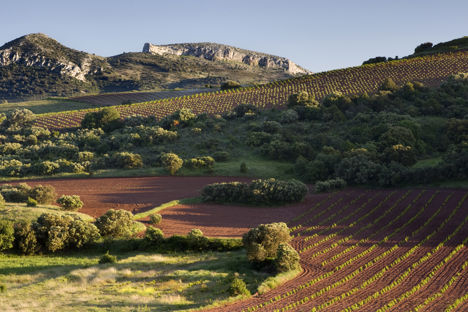
The wine regions of Spain: Campo de Borja
Aragon’s Campo de Borja D.O. produces some of the finest examples of garnacha wines in the world. We take a closer look at this winemaking region and chat to those working at some of its most renowned bodegas.
The wine regions of Spain: Campo de Borja
Aragon’s Campo de Borja D.O. produces some of the finest examples of garnacha wines in the world. We take a closer look at this winemaking region and chat to those working at some of its most renowned bodegas.
The area covered by the Campo de Borja D.O. in Aragon lies just south of the Ebro River, thirty-five miles northeast of Aragon’s capital Zaragoza and its lowest point is an altitude of 1150ft. The air here is so dry you can feel the weight of your eyelids when you blink, you can see way into the distance as it’s too dry for lush forests, and the only plants around are almond trees and vines. ‘It’s not just dry here,’ export manager at Bodegas Borsao, Guillermo Rodríguez tells me when I mention it, ‘we get a wind called El Cierzo which blows up to speeds of 30km/h about 360 days of the year, so it’s not the easiest of climates.’
While it may not be a climate easy on the eyelids, it is however great for wine-making. Grapes have been grown here since at least Roman times but, in common with other parts of Spain, it was only after the Reconquest, with monks building monasteries to consolidate the gains of the Aragonese crown over the Muslims, that wine making practices returned. In Campo de Borja, the Cistercian monastery at Viruela is held responsible for bringing back wine-making to the area and nowadays the monastery building hosts the D.O.’s wine museum.
The grape that works best in this arid climate and at these altitudes is red Garnacha, and the D.O. boasts some vineyards that date back to 1145. ‘Garnacha comes from here,’ explains Rodríguez, ‘as the kingdom of Aragon extended east to what is now the south of France, the Garnacha grape spread, but what is often known as the Grenache variety is originally from around here.’ It’s a grape that likes arid soil and copes well with extreme temperatures, and both Bodegas Borsao and the nearby Bodegas Aragonesas expressed surprise at how well the Garnacha grapes coped with the extreme temperatures and drought of summer 2022. ‘What we have noticed this year with the Garnacha,’ Bodegas Aragonesas enologist Javier Vela says, ‘is that the grapes are smaller and there’s a more concentrated, richer flavour to them. We are all rather astonished at what these vines are capable of withstanding.’
One of the things that the arid, windy climate of Campo de Borja does help with is to keep the vines healthy. ‘Humidity really is the enemy of our grapes and the dry winds prevent all kinds of issues on the grapes, such as moulds and the possible effects of air pollution,’ Vela tells me. ‘It really helps us all maintain sustainable and ecological practices.’
The result of this long history of the Garnacha grape is a high number of old vines, producing a lower yield but a higher quality of grape, and some of the finest examples of single varietal garnacha wine available. Both Borsao and Aragonesas, along with other bodegas in the D.O. sell bottles made exclusively from these old vines - Borsao sells Tres Picos and Aragonesas sells Garnacha Centenaria, and they take great care to really show what Garnacha can do. At the entry level end of the market, younger Garnacha vines are used to make some great rosé wine and both bodegas supply U.K. supermarkets, Borsao to Waitrose and Aragonesas to the Co-Op with their Garnacha rosés, both of which are becoming increasingly popular in the U.K. market.
The Campo de Borja D.O. calls itself the Empire of Garnacha, and from the great Garnacha wines that these bodegas produce, from entry level to limited editions, it’s easy to see why.
Calatayud: Although established in 1990 around the town of Calatayud, about 55 miles southwest of the capital Zaragoza, some of the D.O.s current wineries have been open for nearly a century. Known for big bold red wines made from the garnacha grape, Calatayud has attracted winemakers from the rest of Spain and abroad, who are aware of the possibilities that the area can offer.
Cariñena: South of the river Ebro and north east of Calatayud, this D.O. was created in 1832 and is named after the village of Cariñena, which also gave its name to the once ubiquitous Cariñena grape variety, also known as Carignan. Traditionally the D.O is known for oaked aged wines with big fruity flavours. Nowadays the D.O. produces mostly garnacha reds although the area also makes sparkling white wine under the Cava D.O.
Costers del Segre (in Catalonia): Named after and located on the banks of the Segre river, just north of the Catalan city of Lleida, this D.O., created in 1986, is best known for its white wines using the indigenous Macabeu and Parellada grape varieties as well as the Chardonnay grape, while its red varieties are Cabernet Sauvignon, Merlot, Syrah and Pinot Noir. The D.O. is famous for some of the most innovative wine making in Spain.
Empordà: This D.O. is on the Catalan coast just south of the French border and was created in 1975 although wine has been made here since 6th century B.C. Modern Empordá winemaking is a mix of small farmhouse bodegas, larger state of the art wineries and old buildings turned into bodegas. The D.O. traditionally produces a fortified wine made from the garnacha grape but is now better known for light fruity reds, excellent rosés and high quality cava.


